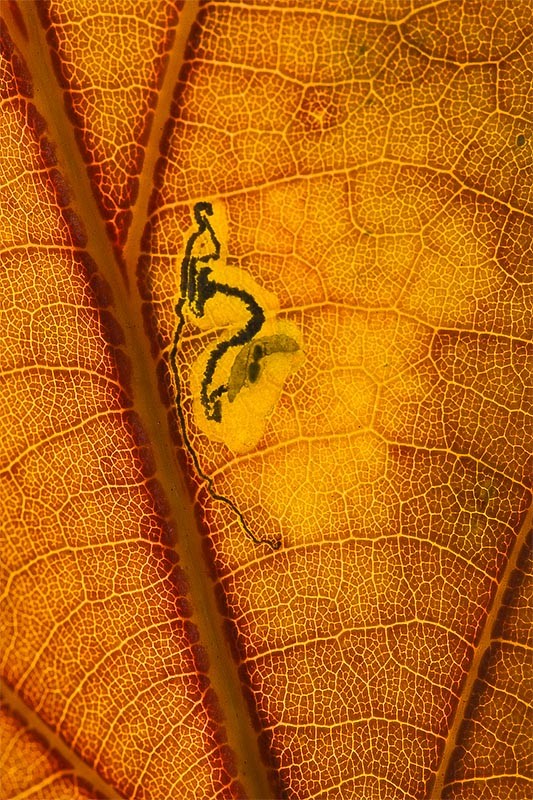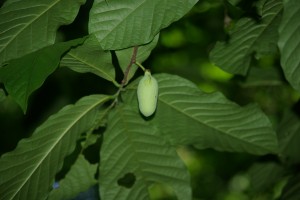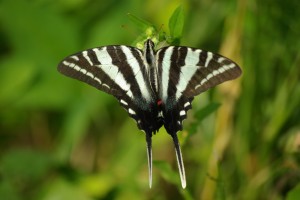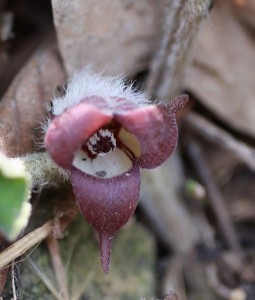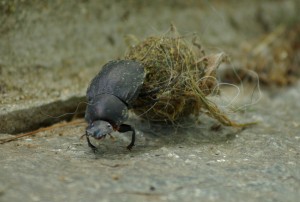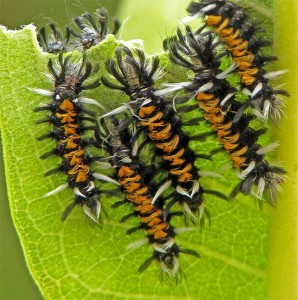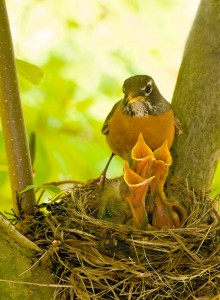Native Plants at the Heart of Life
Our bluff lands — currently a riot of lively green color thanks to plentiful spring rains — offer bountiful grazing to copious numbers of herbivores, which, in turn, become food for others. But, while cattle, sheep, even pigs or deer, all of which are largely destined to become our food, are the animals we generally think of as herbivores, the greatest converters of plant biomass on our lands are not these familiar mammals.
Nearly all plants grow by utilizing photosynthesis — essentially taking energy directly from sunlight. A byproduct of plant growth, of course, is oxygen production, and, quite simply, without plants and their ability to produce the air of life, there would be no life. As food, plants also make all the rest of creation possible. In scientific terms plants are the “first trophic level,” that is, they are the beginning of the food chain for nearly everything else on earth.
Our own food chain often is presented as deceptively simple, as in “cow eats plants, we eat steak.” Rather than being the purely carnivorous species implied, we are, like turtles, coyotes, and chickadees — to name just a few of our “co-feeders,” — omnivores, which eat both vegetable and animal matter.
While the familiar large herbivores do chew up and process significant plant material, the champions of the “second trophic level” are the insect herbivores. The aphids, snails, slugs, grubs, caterpillars, larvae — BUGS AND CREEPY CRAWLIES — transform the solar energy captured by plants into food for themselves and, along the way provide breakfast, lunch, dinner and snacks for just about everything else.
They do this indirectly, by, at some point in their life cycle, acting as a pollinator for a plant. Just as importantly, a very few specialized “bugs” also recycle wastes, turning energy back to the soil for further plant growth. Most of the time insect herbivores pass on the solar energy transformed by plants by simply become a meal for members of the “third trophic level,” the creatures that eat the creatures that eat the plants.
That the trophic levels all are connected and that their interactions are crucial is one of the first lessons in ecology, the science of nature’s web of life. One of the understory trees of our bluff’s woods hints at the wonderful complexities and interconnectedness of all the trophic levels. Pawpaw (Asimina triloba) is a small slender tree, usually no bigger than 10-inches in diameter with the largest specimens at 40 feet in height. The large leaves turn a beautiful golden in autumn, shortly after the large thick fruits ripen in September.
Sometimes called “custard apples,” pawpaw fruits have a complex sweet and tangy flavor and a creamy texture and were highly valued by Native Americans and European settlers and continue to be a favored snack for anyone lucky enough to come upon a selection of ripe fruits during a hike through our woods. Pawpaw fruit contains only a few small seeds, which are spread by either the creatures that eat the fruits and then evacuate the seeds or by sprouting where the ripened fruit falls to the ground. But long before pawpaws have produced fruit and seeds they also have produced a sweet visual treat –“eye-candy” — for us to admire at distances far from the pawpaw’s home deep in our forests.
Pawpaw is the only host plant for the caterpillars, the larval form, of our beautiful Zebra Swallowtail (Eurytides marcellus) butterfly.
These elegantly black-and-white striped, long-tailed, three-to-four-inch wingspaned glories float above fields and gardens, nectaring on various flowers. As the adult butterfly feeds it transfers pollen and so helps those flowering plants reproduce. Adult Zebra Swallowtails females re-enter the woods to lay eggs on Pawpaw leaves, which the developing larvae then consume. But, swallowtail butterflies do not pollinate the flowers of the plant that gave them sustenance as caterpillars.
Only two types of insects pollinate the magenta flowers produced by pawpaws in early spring, and both are tricked into doing this work. Pawpaws are fertilized occasionally by dung beetles, but most often by carrion flies. As their general family names indicate these insects are among those that reduce waste produced by members of the third trophic level, in the case of the beetles by laying eggs in dung, and, for the carrion flies, by laying eggs in dead flesh. Pawpaws fool the insects into pollinating visits by producing flowers that smell — to our senses, not to those of the beetles or flies — of rot and decay. The dung beetles and carrion flies make more pawpaws possible and the pawpaws make Zebra Swallowtails possible.
Zebra Swallowtail butterflies and caterpillars, dung beetles, carrion flies, and their eggs and larvae also become food for others, most notably for birds. Despite the facts that any dedicated backyard bird feeder can easily expend 50 pounds of sunflower seed in any week, and, indeed, bird feeding now is a multibillion dollar annual business in the U.S., there would be no birds if we had no insects.
Approximately 96 percent of all terrestrial birds feed their young on insects or on spiders and their kin, which themselves prey mostly on insects.
The birds we enjoy watching and feeding — our Cardinals, Robins, Bluebirds, Orioles, and Hummingbirds — and the birds we stalk and thrill to hunt — Wild Turkey, Northern Bobwhite — and even the birds we thrill to see hunt — American Kestrels, Red-tailed Hawks — all raise new generations by catching and feeding insects to their young.
But, what if the bugs, the “creepy crawlies,” the members of the second trophic level, all those creatures that move the solar energy produced by plants up and down the food chain, can’t find enough to eat? What if the bugs go hungry? All the creatures that depend on those food sources go hungry, too. And hunger, if protracted, means lowered reproductive success.
New bird surveys indicate that many species are in rapid decline and one of the primary causes seems to be lowered reproductive capacity. This may be due to a shortage of insect foods.
The decline in insect herbivores may be due to the replacement of much of our native vegetation by, first, the expansion of human infrastructure into much that once was available space for wildlife of all sorts. A second, and perhaps even more crucial cause, may be the whole scale replacement of native vegetation by nonnative plants.
Like most creatures — including us — individual species of insect
herbivores eat only certain foods and concentrate upon those acceptable selections. As in the old saying, “water, water everywhere and not a drop to drink,” an insect herbivore in a lush landscape of nonnative greenery may simply starve.
New and ongoing studies which compare the number and amount of insect biomass produced on both native and nonnative vegetation show that native plants produce up to 35 times as many “bug bites.” Even plants that were imported to the U. S. more than two centuries ago do not now support even a tenth the number of insect herbivores that they did in their area of origin.
Simply put, native bugs depend on native plants. Native birds depend on native bugs. So, as we sit, we think, almighty atop the food chain, most of what we eat and drink, and the air we breath, depends on the interdependence of plants, bugs, and trophic
levels. Just as we are learning the economic lessons of foreign dependence, lessons are learned about ecological interdependence. But, unlike an economic “flat earth,” which suggests globalization means no differences exist across borders, ecological borders are less permeable, and more easily torn apart. Native stuff is, simply, the staff of life for the rest of native stuff.
So, what, after all, do we lose if we lose a few, or even a lot of insect herbivores?
A gardener, perhaps, might look for, seek out, and pay a surcharge for a plant that “the #@$$)%)# bugs won’t eat.” And it does seem counterintuitive on any sultry summer evening in our bluff lands as mosquitoes, flies and “no-see-’ems” swarm, making a meal and a trophic level out of us, that any shortage of insect life could occur.
Thriving populations of bug eaters — from the most famed example of Purple Martins, through all the types of birds known as flycatchers and gnatcatchers, as well as dragonflies, bats, and even small mammals — can keep even the “bloodsuckers” in check. But they can only sustain themselves and continue to raise new generations if they have plenty of insect herbivore food. And those grazers of green depend on continuing lush native plant presence.
For more information see the recent publication, Bringing Nature Home: How Native Plants Sustain Wildlife in Our Gardens, by Douglas W. Tallamy, pub. 2007, Timber Press, Inc. Portland, OR.
Clifftop, a local nonprofit organization, is focused on preserving and protecting area bluff lands.
A version of this article appeared in the July 2 2008 edition of the Monroe County Clarion.
© 2008 all content rights reserved, Clifftop NFP.
Comments are currently closed.

